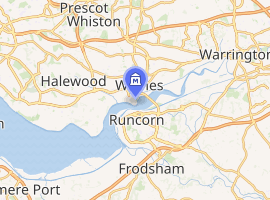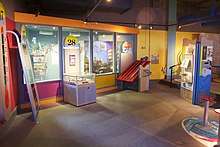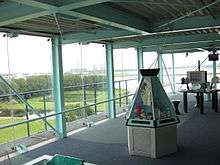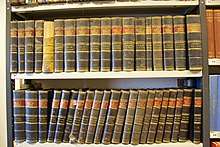Catalyst Science Discovery Centre
The Catalyst Science Discovery Centre is an interactive science and technology museum in Widnes, Halton, North-West England. The centre has interactive exhibits, static exhibits, an observatory, a live-science theatre and family workshops.
 Catalyst Science Discovery Centre. | |

| |
| Former name | Museum of the Chemical Industry |
|---|---|
| Established | 1992 |
| Location | Widnes, Halton, England |
| Coordinates | 53.35184°N 2.73364°W grid reference SJ512841 |
| Type | Science museum |
| Accreditation | Arts Council England |
| Visitors | 30,000 |
| Website | www |
The centre is housed in Tower Building constructed around 1860 by John Hutchinson as the administrative centre for his chemical business and is next to Spike Island. The centre holds a collection of archives relating to the chemical industry, these include documents, photographs and the entire research archive of the ICI General Chemical Division.
History
Catalyst is located in Widnes, Halton, next to Spike Island.[1] The museum is housed in an old four-storey building with modern extensions. The building was originally known as the Tower Building and was constructed around 1860 by John Hutchinson as the administrative centre for his alkali business. It later became the head office of the Gossage soap company,[2] which at one time was the largest of its kind in the world and handled half of the UK's soap exports.[3] Moreover, the town of Widnes was once considered to be the centre of the chemical manufacturing industry in the North West and has strongly been influenced by it for the last 170 years.[3]
The origins of the museum lie in the centenary exhibition of the Society of Chemical Industry in 1982.[4] The development of Catalyst was originally initiated by a number of companies in the chemical industry in partnership with Halton Borough Council. It began as a research project in 1982. A study was conducted to find out whether sufficient material and an appropriate location were available to set up a museum devoted to the chemical industry and a temporary display area was set up in the Old Town Hall in Widnes. It was a very traditional exhibit-based display that dealt in equal parts with the local chemical industry and other local history.[5] By 1986 the space in the Old Town Hall was needed for other uses so Catalyst moved to its present location in the Gossage Building in the West Bank area of Widnes.
The museum opened as "The Museum of the Chemical Industry" in 1989.[6] It was said to be the world's first museum dedicated to the chemical industry.[4] A glass lift and an enclosed glazed roof-top observation deck, designed by Austin-Smith:Lord,[7] were added to the building in 1989 as part of the development of it into a museum.[8] In 1991, Rintoul was also the person who initiated the project for a new gallery in which visitors would be able to explore aspects of the chemical industry by "See,Touch,Do" exhibits.
In 1994–95, an extension was added to the north to provide an education centre and visitor services.[8] Although the museum is relatively young, it has already seen some major changes of location and of the exhibition concept, especially during the first years after its establishment.[9][10] According to former director Gordon Rintoul, as quoted in an article about the opening of the new building, one of the main purposes of the museum was to forge closer links between industry and the public.[3]
Facilities


The centre focuses on chemistry and the history of the chemical industry.[11] In addition to static exhibitions and hands-on experiments, it contains the Alchemy Theatre which gives three-dimensional presentations and allows interactive voting.[12] Family workshops are arranged during school and bank holidays.[13] The centre organises a monthly Science Club for children aged 11–14 years, and OATS (Over Age Teenage Scientists) for those aged over 14 years.[14]
The exhibits range from test tubes to a 20-ton cast iron caustic soda finishing vessel, laboratory equipment, and chemical samples. Catalyst has also collected some local social history objects which have helped to give a human context to the collection as a whole. The collection has concentrated, in terms of industry, on the salt-based chemical industries of Merseyside, South Lancashire and North and Mid Cheshire, along with other chemical industries that have arisen in these areas. The social history collection has been confined to Widnes and Runcorn and its environs.[5]
The museum attracts some 30,000 visitors per annum. About 25% of the current annual total is accounted for by school classes for which Catalyst provides an education program that links directly to the National Curriculum. Catalyst holds the accreditation of 'Quality Assured Visitor Attraction' and to date, has won a number of major awards, including the prestigious Gulbenkian award.[9] There is an observatory on the top floor of the museum offering panoramic views of the River Mersey, Spike Island and the Mersey Gateway Bridge. The observation deck was designed by Lord Austin-Smith.
Archives

The museum holds a collection of archives relating to the chemical industry. The collection was started in 1982 with the setting up of the Halton Chemical Industry Museum Project as a project funded by the Manpower Services Commission and Halton Borough Council. The collection consists of nearly 8,000 individually numbered items and groups including objects, archive material and photographs. However, in terms of physical numbers of individual items and items within groups, the number of items approaches 10,000. If the individual research files from the ICI General Chemicals Group are also included then the collection would exceed 35,000 items.[5] More information about the collections can be found on the Catalyst website.[15]
The archives include company documents of all kinds, product brochures and general ephemera, consisting of documents, photographs and the entire research archive of the ICI General Chemical Division [16] (including pre-war personal injury records), Peter Spence Archive, Hutchinson Dock Estate Papers, and the Clayton Aniline Company Archive, McKechnie Brothers ledgers, the Vine Chemicals/Barium Chemicals Limited documents,[5] documents from J.W. Towers and Company (later Gallenkamps).[15]
The photographic collection, consisting of 35mm negatives and photographs, documents products and processes, company history, social activity and local history from Merseyside, South Lancashire, and North and Mid Cheshire areas. The collection also houses photographic material from the Teesside Bridge & Engineering Company. They also hold on loan the Brunner Mond film collection.[5] The library comprises several sets of bound volumes including the Journal for Society of Chemical Industry, and the Imperial Chemical Industries magazine and newspaper. There are also many individual volumes relating to aspects of chemistry and industry, and to local area.[5]
The map collection consists of Ordnance Survey maps of Widnes and Runcorn, and includes various Halton Borough Council annotated maps such as the sewer system in Halton, two complete sets of Ropers 1875 survey, a bound set of plans of the proposed Lancashire Plateway relating to Widnes and a set of Transporter Bridge bound plans.[5] The fine art collection ranges from portraits of local chemical manufacturers in oils and pastel, and depictions of local factories.[17] The collection also includes bronze busts and plaques.[5]
See also
| Wikimedia Commons has media related to Catalyst Science Discovery Centre. |
References
- "How to Find Us". Catalyst. 8 August 2015.
- Hardie, David William Ferguson (1950). A History of the Chemical Industry of Widnes. London: Imperial Chemical Industries Limited, General Chemicals Division. p. 56. ASIN B0007JBZRQ.
- Crosland, Lesley (May 1989). "CATALYST A Museum For Change". STEAM Magazine.
- Emsley, John (19 August 1989). "The wonderful world of Widnes: Catalyst, the museum of the chemicals industry, Widnes, Cheshire". New Scientist. Reed Business Information. Retrieved 8 August 2015. Google Books
- "Catalyst 2008 Acquisition & Disposal Policy". Catalyst. Archived from the original on 15 August 2009.
- James, Tony (15 August 1992). "Review: Catalyst loses its modesty and comes of age". New Scientist. Reed Business Information. Retrieved 23 March 2008.
- Letter from the director Dr Gordon Rintoul to Mr TT Young, Chief Leisure & Operational Services Officer, Halton Borough Council, 7 December 1988.
- Pollard, Richard; Nikolaus Pevsner (2006). The Buildings of England: Lancashire: Liverpool and the South-West. New Haven & London: Yale University Press. p. 650. ISBN 978-0-300-10910-8.
- Catalyst Press Pack Info Updated 2008
- Internal Catalyst document: Notes on CATALYST Development for Rainhill Rlwy. Soc. 11 October 1993
- "About us". Catalyst. Archived from the original on 31 July 2015. Retrieved 8 August 2015.
- "Education". Catalyst. Retrieved 24 March 2008.
- "Workshops". Catalyst. Archived from the original on 28 December 2012. Retrieved 7 January 2013.
- "Science Club". Catalyst. Archived from the original on 20 July 2008. Retrieved 8 August 2015.
- "Catalyst 'All about our Collections'". Catalyst.
- "Collections and Historical Documentation". Catalyst. Retrieved 23 August 2008.
- "Public Catalogue Foundation - Catalyst". Public Catalogue Foundation. Retrieved 8 August 2015.